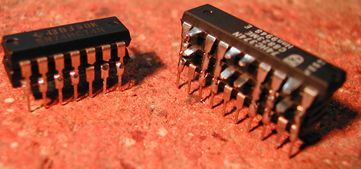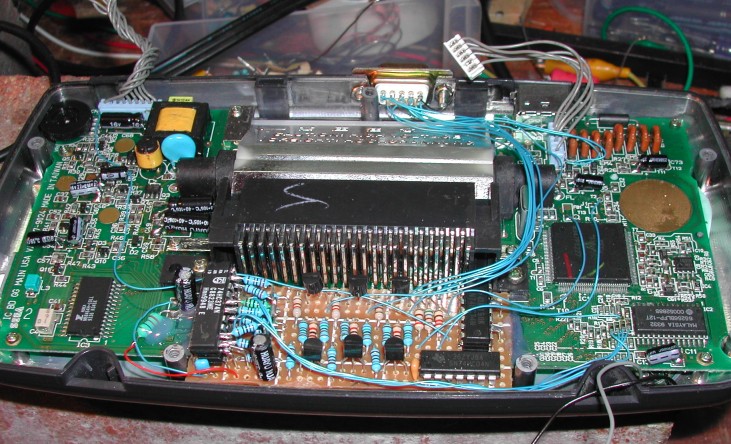[EvilTim] dug deep into a classic system to finally give the Game Gear a proper video output. The Game Gear was Sega’s answer to Nintendo’s Gameboy. Rushed to market, the Game Gear reused much of the hardware from the very popular Master System Console. The hardware wasn’t quite identical though – especially the cartridge slot. You couldn’t play Game Gear games on a Master System, and the game gear lacked an AV output, which meant gamers were stuck playing on a small fluorescent backlit LCD screen.
[EvilTim] wanted to play some of those retro titles on a regular TV using the original hardware. To accomplish this he had to start digging into the signals driving the Game Gear’s LCD. The Master System lineage was immediately apparent, as Game Gear’s LCD drive signals were similar in timing to those used to drive a TV. There was even a composite sync signal, which was unused on in the Game Gear.
 [EvilTim] first designed a circuit using discrete ’74 series logic which would convert the LCD drive signals to SCART RGB. Of note is the construction technique used in this circuit. A tower of three 74HC374 chips allows [EvilTim] to create R, G, and B outputs without the need for a complex circuit board.
[EvilTim] first designed a circuit using discrete ’74 series logic which would convert the LCD drive signals to SCART RGB. Of note is the construction technique used in this circuit. A tower of three 74HC374 chips allows [EvilTim] to create R, G, and B outputs without the need for a complex circuit board.
As pretty as a three-story chip tower is, [EvilTim] knew there was a better way. He re-spun the circuit with a 32 macrocell CPLD. This version also has an NTSC and PAL video encoder so those without a SCART interface can play too. If you’re not up to building your own, [EvilTim] sells these boards on his website.
We’ve seen some incredible retro gaming hacks over the years. From a NES inside a cartridge to incredible RetroPi builds. Hit the search bar and check it out!

















I miss my GG. Practically pristine. Even had the TV cartridge. Ate batteries though.
There is RetroArch for android, and cheap Bluetooth game pads.
In some places, the ROMs are only legal if you own the original cartridge.
shame that emulators never get the sound right.
GenesisPlusGX is just about perfect – it even gets the intro sound for Comix Zone (Picodrive misses this completely), as well as handling the SegaCD Mode 1 access from cart that’s used by Flux and Pier Solar.
It’s one of the RetroArch cores.
Double-bonus, there’s an LCD shader in RetroArch that mimics the GG’s display, including the horrible motion blur.
I was impressed enough when Genecyst got the Z80 sound working.
Seems that emulation sorta misses the point, though. I’m as much as fan of RetroArch as the next guy, but there’s something visceral about playing on the original hardware. If you can, why not? Besides, isn’t the technical challenge part of the fun?
You can do an LED backlight mod to roughly triple the battery life. Or if you hate the original LCD, there’s this mod to replace it with a nice new one: https://www.dragonbox.de/en/385-gamegear-lcd-mod-mcwill-console-mods-4260416651135.html
I’ve done both mods, LED backlight panel is super cheap but difficult to install and you may easily crack your screen in the process.
The McWill screen requires some moderate skill with surface-mount soldering, as you’re removing several components, transplanting a component, and then replacing a few with different values from the included kit. It’s also significantly more expensive.
Difficulty-wise, the common led backlight replacement is harder but requires a little less soldering skill, whereas the McWill requires more skill but is easier and safer to install for those that can do it.
Also, the McWill screen is a modern 320x240ish display, which does not work well for fullscreen scaling of Game Gear games as the GG’s screen resolution is not evenly divisible into 240p. There’s a scanline mode which hides some of the scaling artifacts fairly well in still frames, but is more noticeable in motion.
It’s basically perfect for SMS games, though – you can read text!
The Sega Nomad was a lot cooler than the GG. It played Genesis cartridges (a few didn’t work), had a video out, and had a plug for a 2nd controller. I still have one.
Does it work?
I got it for cheap years ago, and it wouldn’t turn on. I found some loose ground connections inside, fixed them, and it worked well. Got a lot of use out of it.
Currently, it won’t turn on again, but I haven’t tried to fix it again yet. I’m quite sure it’s just another bad connection. When I had it apart before, it looked really prone to that sort of thing.
They commonly have issues with the power supply section of the board, one of the components typically needs to be replaced. People claim it’s a regulator, but to me it appears to be a transistor being used as a switch of sorts. In that case simply bypassing it would work for normal operation, but you may lose the ability to do things like safely charge a rechargeable battery pack from the built-in supply circuitry.
They also commonly have problems with bulging capacitors.
That’s a given. Even if they’re not bulging, assume they’re dry and replace.
Thanks, I’ll keep that in mind when I take another look at it
There is also version with scaler, here is a link comparing scaler version to Tims one:
http://retrorgb.com/gamegearrgb.html
and LCD mod (McWills LCD), replaces casio watch LCD technology with brand new 320×240 display.
http://retrorgb.com/gamegearmcwilllcd.html
McWill’s LCD mod (which has been available for about a year now) may be expensive but it also offers faux LCD effect with vertical lines both in LCD and on VGA output to simulate old GG LCD display, plus it auto scales games so there’s no black border. The older RGB mod does not scale Game Gear on output or on new internal LCD because Game Gear operated at lower resolution than SMS games. I have not experienced with the 3rd one yet.
Seems a lot easier than adding video output to a Gameboy… why did (and does) Nintendo make things so complicated? They’ll never understand that more hackability means more consoles sold.
Hackers will never understand that Nintendo does not make their money selling consoles. It’s the games that bring in the big bucks. More ‘hackability’ leads to unlicensed software or even piracy and that actually means less money.
The original DMG takes advantage of being able to stall the pixel clock in order to make the rest of the design cleaner. Can’t do that on a CRT.
That, and the DMG’s LCD had no reason to resemble a TV in any way. There was certainly never going to be a cart that let you watch TV on it, in 4 shades of greeny-yellow. And since it wasn’t a bastardised Master System, they were completely free to design around the LCDs they chose. The GG had those connections, the TV tuner and the SMS back-compatibility, that meant it was worth the trouble of making the display system fit fairly well with TV screens.
You CAN run GG games on an SMS, if you rig up a pin convertor, but the colours will be wrong. Someone from RGVC did it back in the 1990s. Because the SMS had a smaller palette range than the GG. It seems likely that if you could account for that, perhaps by adding extra palette hardware between the SMS’s RGB video output and the screen to increase it’s colour depth, or by replacing accesses to GG palette registers with SMS ones, you could solve that.
http://retrorgb.com/gamegearongenesis.html
Ah, here we go. Someone’s done the thing I was gonna post, but then decided against cos I’d waffled enough… an automated ROM patcher to convert Game Gear game to Master System, which you can then run on an emulator (for some reason), or on a real Master System with an SD card player cart. There were a few GG games that weren’t made for the Master System, it’s official lifespan was a bit longer than the SMS’s.
I am actually building a gameboy to HDMI converter (hdmyboy) and am nearly finished, though admittedly it has taken me quite a long time to get the video output ‘perfect’. The video format to the LCD is pretty straight forward to get correct for the first 99% but the remaining 1% is a bit quirky.. I only need to fix the audio and then I’m finally done :D (4 year project pfff)
I’d love to read about it. Any link, or write-up?
You can do a lot with the Game Gear. Add a controller to this and make it a console. I document how I’ve done it at https://www.facebook.com/gamegearconsole/
Must be a slow news day. This has been a thing for at least the past 10 years.
McWill’s board allows VGA out as well as a better screen.
the site reports at the bottom: Last modified 30/12/2013
The original project with discrete logic components was published 10 years ago :
https://web.archive.org/web/20061108010458/http://members.optusnet.com.au/eviltim/ggrgb/ggrgb.html
But contrary to McWill mod and other well advertised “look what i’ve done that you can buy” closed products (which IMHO souldn’t be reported on HaD), even with its limitations, this one is technically well explained, easy to build, and there are updated versions with schematics and simple source code for CPLD (great for beginners), so thanks to Adam Fabio for reporting a (not so common) well documented and interesting “retro-console” project, even if it is not news.
I seem to remember a similar mod sometime in the mid to late 90’s published in a gaming magazine. Electronic Gaming Monthly? GamePro? Unfortunately, I can only remember one detail, possibly two. The hack involved sacrificing one of the battery compartments for the V/A outputs to the TV. Meaning you had to have the power supply in order to power the system. I recall thinking this was a dumb idea since it destroyed the portability of the GG. The second memory is, I think the article was centered around the idea this could be done to a GG with a bad backlight and I remember wondering, why not just replace the light?
I still have nearly every game mag I purchased back then so I might still have the article. I just have no idea which one.